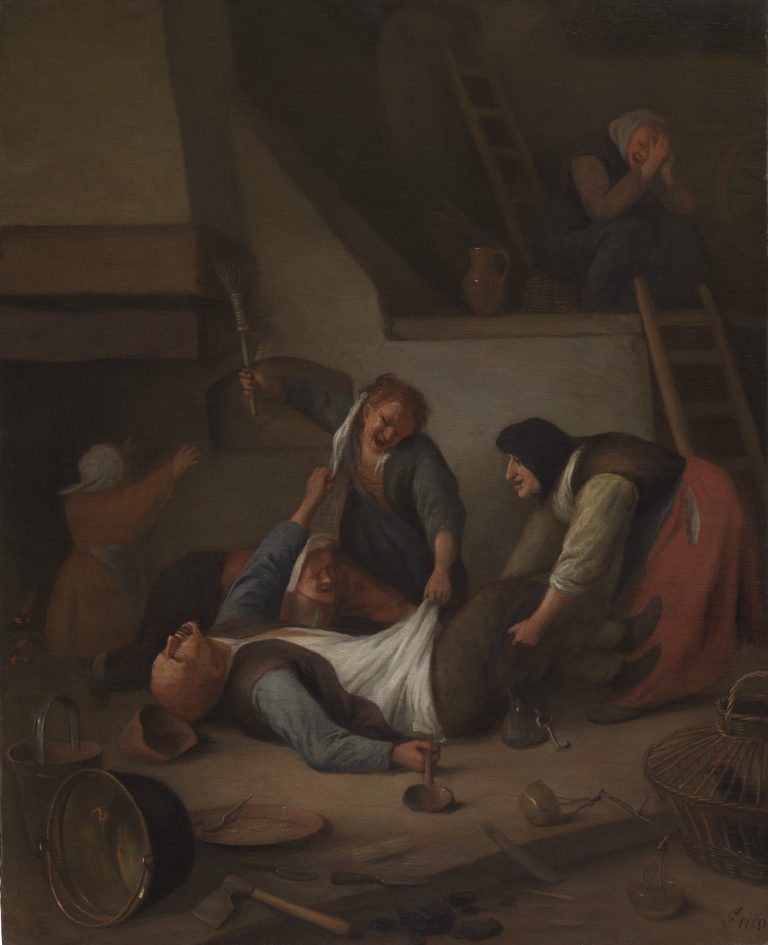Near a fireplace in a simple interior, three women flog a man who lies helpless before their onslaught. One of them has grabbed hold of his shirt and is about to whack him with a short broom while another woman laughingly pulls on his pants. A third woman tugs at his trousers, possibly in search of his purse, which, in fact, lies between his legs, with a key attached to its a clasp. The man’s only weapon in this struggle is a wooden spoon that he holds loosely and ineffectively in his right hand. With his other hand he grabs the white headscarf worn by the woman with the broom, but his efforts at defending himself are meager at best. As he lies on the floor, he gapes upward, his cap having fallen from his head, revealing his closely cropped red hair. Behind this tussling group a child reaches for the bread oven to the right of the fireplace, while on a raised landing accessible by ladder, a seated woman observes the scene and laughs behind her hands.
Mockery of the man who cannot live up to his role as the woman’s better half was the theme of numerous representations throughout the ages.1 A brawl in which women beat up a man is an indication of an “upside-down world,” where the traditional roles of men and women have been reversed, a theme that Jan Steen often painted. A wooden spoon and a bunch of keys, for example, are objects typically carried by a housewife. Steen’s painting also is related to another popular subject, the so-called “Struggle for the Breeches.” A composition in a somewhat similar vein is Salomon Saverij’s 1610 etching after a print by Joos Goeimare (1578–1611) (fig 1).2 In that print, three women thrash a drunken man’s bare buttocks because he let his family suffer deprivation. In Steen’s painting, the child gesturing toward the bread oven probably also connotes that the family suffers from lack of food. The women, fed up with the man’s failure to rule the roost, have decided to punish him.
In the foreground Steen skillfully rendered a number of objects, including a kettle, bucket, knives, matchsticks, hatchet, a caged basket holding a chicken or a rooster and, most notably, a pair of scales. Even though these items presumably relate to the pictorial narrative, their meanings in this context are not entirely clear. However, the scales probably relate to the Dutch expression that things are “out of balance.” The chicken basket in the right foreground seemingly indicates that the man is a “hen-groper,” a bungling idiot who meddles in household affairs but is not worth a straw. It might also be a reference to the well-known metaphor of the hen who crows rather than the rooster.3
The painting’s allusion to a topsy-turvy world recalls the work of Pieter Bruegel the Elder (1525–69) and Pieter Aertsen (1508–75), artists who were certainly important to Steen. The power of women over men plays a role in many of Steen’s paintings. However, among his scenes of brawling peasants, this painting is an exception, since it does not portray the usual tussling card players or boozers.4 The only direct connection that can be discerned between this painting and another of Steen’s works is a painting dated either 1671 or 1674 (present whereabouts unknown), in which a woman seen from the back lifts her arms upwards in a way comparable to the child (but in reverse).5
Dendrochronological examination has shown that this painting is likely to be one of Steen’s late works: the panel would not have been ready for use until after 1668.6 A dating to around 1670–73 is most plausible. Cornelis Hofstede de Groot believed that the painting was in poor condition (“Genuine, but has suffered severely”).7 That assessment, however, was not confirmed during restoration, at which time damage was observed only near one of the ladders.8 It is also possible that Hofstede de Groot’s negative opinion was prompted by the signature, in which part of an original E had disappeared, causing it to look like “JStien.” His opinion might also have been influenced by the slightly flat character of the execution, which lacks Steen’s customary brilliance. This uniformity of brushwork can perhaps be explained by the involvement of a studio assistant, as is often the case in Steen’s late work. The composition, however, is intelligent and original, entirely in keeping with the master’s manner of painting. A few pentimenti discernible in the wooden spoon, the sleeve of the kneeling woman, and possibly the broom demonstrate Steen’s searching efforts to create a pleasing and compelling conception.
